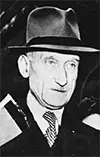The European Coal and Steel Community
The European Coal and Steel Community (ECSC) was an international entity that fostered communication and cooperation between nations in the second half of the 20th Century. Many people regard the ECSC as the progenitor of the European Union. 
The original public idea of the ECSC came from Robert Schuman (left), who was Prime Minister of France after World War II. To mark the fifth anniversary of the end of that war, Schuman, then Foreign Minister, proclaimed the joining of France and West Germany, primarily, but other European countries as well in a common market for coal and steel. Schuman and his government had in mind to bring the two longtime antagonists together as a means of preventing yet another conflict between them; it was no accident that coal and steel had powered the war machines of the antagonists; however, the economic elements of the common market were more forward-looking and wide-ranging because of the abolishment of customs duties, subsidies, and other kinds of restrictive practices. Yet another Treaty of Paris came along in 1951, and the result was the creation of the ECSC. It wasn't just France or West Germany onboard; also joining were Belgium, Italy, Luxembourg, and the Netherlands. (All but Italy were already engaged in negotiations that would eventually create the Benelux Union.) Support for the ECSC within the French political apparatus wasn't absolute; as well, many in the West German government spoke out in opposition to such an endeavor. However, the parliaments of all six nations voted in favor of creating and joining the ECSC and so it came into being, signed on April 18, 1951 and beginning operation on July 23, 1952. 
A suite of institutions supplied the infrastructure for the running of day-to-day business of the ECSC. The High Authority was the overall top organization; it was the equivalent of the executive branch of a representative government, and its members were appointed. Member nations sent representatives to be part of the Common Assembly and ministers to be part of the Special Council and judges to be part of the Court of Justice. The theory behind the intermingling of the duties of these four institutions was the idea of checks and balances. The base of most of these institutions was Luxembourg City. The High Authority had nine members: two each from France, Germany, and Italy, and one each from Belgium, Luxembourg, and the Netherlands; those eight together voted to elect another person as President, who served until replaced. Five men in all served in that capacity: two from Belgium, two from France, and two from Italy. Provisions of the Treaty of Paris prohibited all of these people from having any conflicts of interest. In the Common Assembly were 78 representatives: 18 each from France, Germany, and Italy; 10 from Belgium and the Netherlands; and four from Luxembourg. Members served a one-year term. Nominally, the Common Assembly could overrule actions of the High Authority. Members of the Common Assembly elected a president, who served until replaced; four men in all served in that capacity: two from Italy and one each from Belgium and from West Germany. Making up the Special Council of Ministers were high-level representatives of the members governments. This body, too, had a presidency; the terms of service for this office were a bit different from the others, though. The President of the Special Council of Ministers served a three-month term, and then gave way to a representative to the next member country in alphabetical order. Seven judges made up the Court of Justice; each of these judges, appointed by agreement of the member nations, served a six-year term. The judges regulated legal issues in terms of laws and practices stipulated by the Treaty of Paris. The creators of the ECSC envisioned for it a 50-year lifespan, and that it had, expiring on July 23, 2002; by that time, it had been superseded by the European Economic Community and then the European Union. |
|
Social Studies for Kids
copyright 2002–2024
David White




